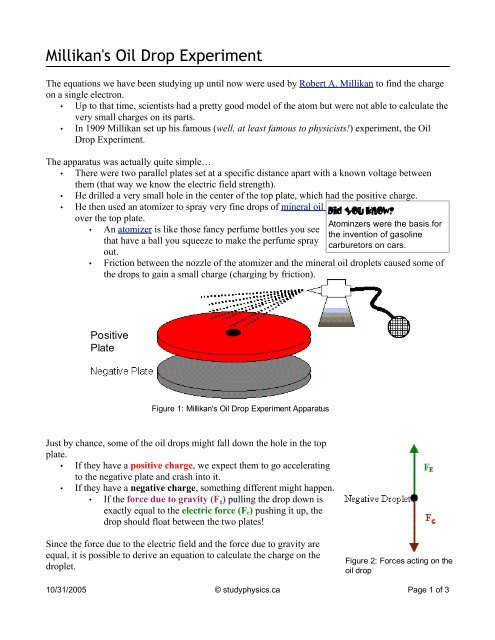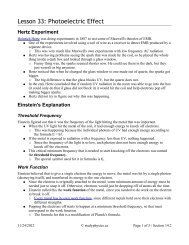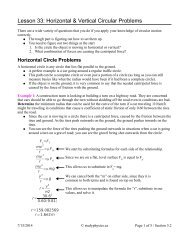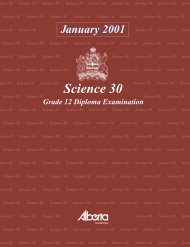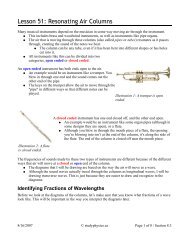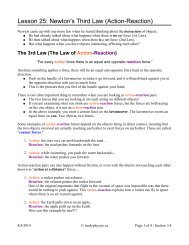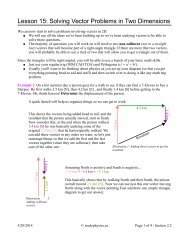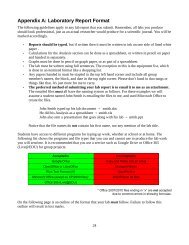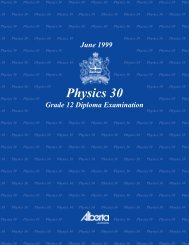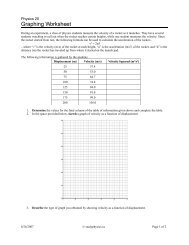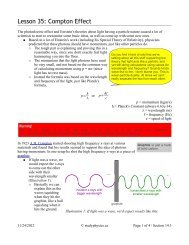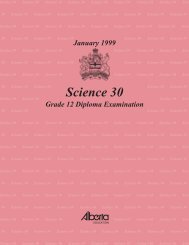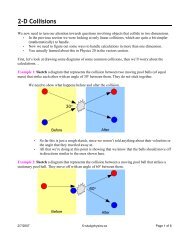Create successful ePaper yourself
Turn your PDF publications into a flip-book with our unique Google optimized e-Paper software.
<strong>Millikan's</strong> <strong>Oil</strong> <strong>Drop</strong> <strong>Experiment</strong><br />
The equations we have been studying up until now were used by Robert A. Millikan to find the charge<br />
on a single electron.<br />
• Up to that time, scientists had a pretty good model of the atom but were not able to calculate the<br />
very small charges on its parts.<br />
• In 1909 Millikan set up his famous (well, at least famous to physicists!) experiment, the <strong>Oil</strong><br />
<strong>Drop</strong> <strong>Experiment</strong>.<br />
The apparatus was actually quite simple…<br />
• There were two parallel plates set at a specific distance apart with a known voltage between<br />
them (that way we know the electric field strength).<br />
• He drilled a very small hole in the center of the top plate, which had the positive charge.<br />
• He then used an atomizer to spray very fine drops of mineral oil<br />
over the top plate.<br />
• An atomizer is like those fancy perfume bottles you see<br />
that have a ball you squeeze to make the perfume spray<br />
out.<br />
Did You Know<br />
Atominzers were the basis for<br />
the invention of gasoline<br />
carburetors on cars.<br />
• Friction between the nozzle of the atomizer and the mineral oil droplets caused some of<br />
the drops to gain a small charge (charging by friction).<br />
Positive<br />
Plate<br />
Figure 1: <strong>Millikan's</strong> <strong>Oil</strong> <strong>Drop</strong> <strong>Experiment</strong> Apparatus<br />
Just by chance, some of the oil drops might fall down the hole in the top<br />
plate.<br />
• If they have a positive charge, we expect them to go accelerating<br />
to the negative plate and crash into it.<br />
• If they have a negative charge, something different might happen.<br />
• If the force due to gravity (F g ) pulling the drop down is<br />
exactly equal to the electric force (F e ) pushing it up, the<br />
drop should float between the two plates!<br />
Since the force due to the electric field and the force due to gravity are<br />
equal, it is possible to derive an equation to calculate the charge on the<br />
droplet.<br />
Figure 2: Forces acting on the<br />
oil drop<br />
10/31/2005 © studyphysics.ca Page 1 of 3
F E<br />
= F g<br />
qE =mg<br />
q= mg<br />
E<br />
To find the charge on the droplet, Millikan needed to know three things:<br />
1. g the acceleration due to gravity was easily measured by Millikan. For our calculations, we<br />
will continue to assume 9.81m/s 2 .<br />
2. E the electric field in the plates could be calculated by measuring the distance between<br />
the plates and the voltage. You then use E= V to calculate the electric field.<br />
d<br />
3. m the mass of the droplet. How do you measure the mass of an oil droplet<br />
Finding the mass of the oil drop was especially difficult since it usually only floated for a couple of<br />
seconds and then splattered on the bottom or top plate.<br />
• Millikan had two solutions to this problem…<br />
1. First, he used a miniature telescope with hash lines etched onto the glass.<br />
2. If you looked into the scope you’d see something like this:<br />
Figure 3: Hash lines cut into the<br />
glass lense.<br />
• By knowing the distance between the hash marks, Millikan could measure the<br />
diameter of the oil drops.<br />
• There was still one problem… as the oil drops fell, they had a raindrop shape.<br />
• This meant that Millikan couldn’t just calculate the volume of a perfect<br />
sphere for his calculations.<br />
• This led to another solution... based on a series of complex calculations using<br />
the viscosity (thickness), air resistance, and other properties of mineral oil,<br />
Millikan was able to relate the diameter of the oil drop to its mass.<br />
Now all he had to do was see one of these oil drops float in front of the scope.<br />
• Oh, is that all!<br />
• Millikan spent thousands of hours squinting through that scope, desperately trying to see drops<br />
float and quickly measure their diameter.<br />
• After thousands of trials, Millikan was able to show that all of<br />
the charges he calculated were multiples of one number…<br />
1.60 x 10 -19 C<br />
Did You Know<br />
As of 1986 the most precise and<br />
accurate measurement of the<br />
elementary charge is 1.60217653(14)<br />
x 10 -19 C. The last two numbers are in<br />
brackets because although they are<br />
considered “questionable”, they might<br />
still be applied in some calculations.<br />
10/31/2005 © studyphysics.ca Page 2 of 3
• Since he never spotted a smaller charge, he concluded this must be the charge on a single<br />
electron (and proton).<br />
• Because it is the most basic charge possible he called it an elementary charge , e.<br />
Example 1: An oil drop in a Millikan apparatus is determined to have a mass of 3.3e-15 kg. It is<br />
observed to float between two parallel plates separated by a distance of 1.0cm and with a 340V<br />
potential difference between them. How many excess (extra) electrons are on the drop<br />
We first need to calculate the strength of the electric field between the two plates.<br />
E= V d = 340V =3.4e4 N /C<br />
0.010m<br />
Now we can calculate the charge on the drop.<br />
F e =F g<br />
qE=mg<br />
q= mg<br />
E<br />
q= 3.3e-15kg9.81m/s2 <br />
=9.5e-19C<br />
3.4e4N/C<br />
But the question asked how many excess electrons are on the drop, not for the charge. Since we<br />
know one electron has a charge of 1.60e-19 C…<br />
(9.5e-19C) / (1.60e-19 C) = 5.9<br />
We round this off to get the final answer, six excess electrons.<br />
10/31/2005 © studyphysics.ca Page 3 of 3


